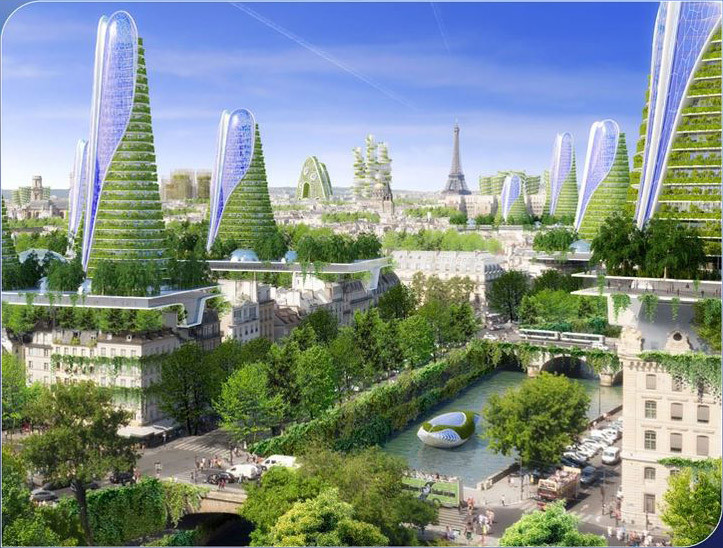A smart, eco-friendly city is one that combines the power of digital technology and sustainable practices to improve the quality of urban living. The concept is built around the use of sensors, data, and other connected systems to enhance urban services, including water, energy, transportation, and waste. However, what sets eco-smart urban cityscapes apart from others is their clear emphasis on minimizing the environmental impact. They are awash in renewable energy and green buildings, as well as low-emission transportation and strategies for reducing waste. They are built to be inclusive, flexible, and efficient, providing possibilities for innovation while enhancing the overall quality of life in cities. The combination of both technological and ecological solutions is the reason the cities are distinct as examples for future city development.
Smart Energy Solutions for a Greener Future
One of the pillars of eco-friendly cities is the utilization of energy systems that are smart. These solutions involve the integration of energy from renewable sources, like wind, solar, or geothermal, into the cities’ electric grids. Smart grids enable continuous monitoring and efficient distribution of electricity, which reduces pollution and waste. Buildings are equipped with systems for managing energy that control lighting as well as heating and cooling according to the occupancy level and the environmental conditions. Streetlights that are powered through solar panel systems and motion detectors cut down on the energy consumption while also providing security. These advances result in significantly lower carbon footprints as well as encourage energy independence for cities. In a move away from fossil fuels and toward sustainable technologies, eco-friendly cities are setting new standards for urban energy usage.
Sustainable Transportation and Mobility
Eco-smart cities are reinventing urban mobility while putting sustainability as the primary goal. Traditional infrastructure that is primarily based on cars is being replaced with multimodal transportation networks, which include electric buses as well as shared bicycles, e-scooters, and pedestrian-friendly paths. The public transportation system is modernized with new digital tools that offer real-time updates as well as smart ticketing and route optimization to increase efficiency and decrease emissions. Electric vehicle (EV) chargers are being widely used to promote the transition from gas-powered vehicles to electric ones. Smart traffic management systems can reduce pollution, and congestion, and decrease energy consumption. These transport innovations can improve air quality and make life easier for residents.
Intelligent Waste and Water Management
Water and waste management are crucial to sustainable urban living. Smart cities are using technology to enhance these processes and be sustainable. Smart bins that are equipped with sensors will determine when they are full and alert the collection teams, maximizing waste collection routes and decreasing unnecessary trips. AI-based sorting systems simplify recycling. Likewise, composting facilities help reduce waste in landfills. Innovative technologies that save water, like leak detection sensors, as well as automatic irrigation systems, can help conserve water resources. Rainwater harvesting and recycling systems can further improve sustainability. By minimizing environmental damage and encouraging conservation, these sophisticated systems ensure proper management of essential resources.
Green Architecture and Urban Planning
Eco-innovative smart cities prioritize the construction of public spaces and buildings. Green architecture refers to building structures that are energy efficient, built from sustainable materials, and designed to minimize the environmental impact. Green roofs, naturally ventilated buildings, insulation with high efficiency, and solar panels are all common in eco-friendly structures. The urban planning process in these cities involves an increase in green space, such as gardens, parks, and urban forests. They enhance air quality and provide people with areas for relaxation and leisure. Urban farming and vertical gardens are also gaining popularity in cities with high density. These initiatives not only improve the beauty of cities but also aid in reducing urban heat islands and increasing the environment.
Challenges and the Way Forward
Despite the numerous benefits, constructing eco-friendly smart cities is not without its difficulties. High upfront costs, privacy concerns about data, and the digital gap could hinder progress. Furthermore, sustainability requires coordination between government agencies as well as private sector companies and the public. However, we can overcome these challenges with proper planning and investment policies. Urban living’s future is in the constant development of sustainable and smart methods. The government must ensure that eco-innovation stays people-centric, flexible, fair, and equitable. As the pace of technological advancement and the public’s awareness increase, more and more cities are likely to be part of this revolutionary movement, creating the conditions for a cleaner and more intelligent world.
Conclusion
The emergence of eco-friendly smart cities is a significant change in the way we envision our future urban lifestyle. These cities prove that sustainability and technology are not antagonistic forces but complementary tools that can be used together to tackle the complicated problems of modern-day life. Smart technologies encompass everything from energy management and transportation to sustainable buildings and even digital government. Smart urbanism designs every element to enhance the well-being of both humans and the environment. As the road to the full-scale implementation of smart cities is in process, the progress that has been made thus far is both inspiring and hopeful. When cities embrace eco-innovation, they could become the engines for resilient and sustainable growth. The bottom line is that smart cities aren’t only about the latest technology or gorgeous structures. They are about creating a world in which people and the earth can thrive in harmony.
FAQs
1. What exactly is an environmentally friendly, smart city?
A smart city that is eco-friendly and innovative is an urban space that makes use of technological advancements along with sustainable strategies to increase living standards, lessen the environmental impact, and improve the efficiency of public services.
2. What can smart cities do to help combat the effects of climate change?
Smart cities help reduce carbon emissions by encouraging renewable energy, sustainable transportation, and efficient buildings, as well as smart resource management, which contributes to the fight against climate change.
3. Are eco-smart cities affordable for developing countries?
Yes, many eco-innovative strategies are cost-effective and scalable with international support, and technological advances help developing nations to implement these solutions.
4. What role will citizens play in smart cities?
Citizens are the key players who use digital platforms to participate in decision-making, discuss issues, and engage in sustainable behavior that supports the city’s objectives.
5. Are there examples of smart city technology?
Examples include smart grids for energy management, traffic management systems, sensors for monitoring waste, smart water meters, and mobile apps for public service and sustainability monitoring.




